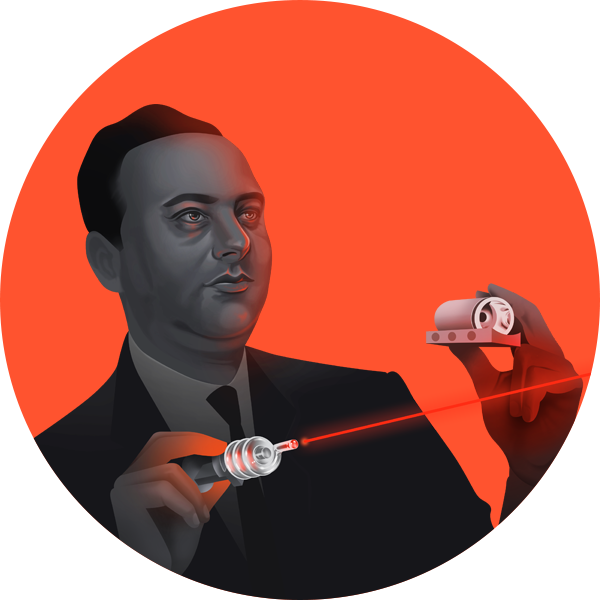The unrecognized pioneer
60 years ago, Theodore Maiman powered up the very first laser. At that time, however, neither industry nor research saw any practical application for the technology. The story of a major misjudgment.

While Theodore Maiman saw the light in the spring of 1960, the “Physical Review Letters” journal was struck blind: Its editors refused to publish the physicist’s great breakthrough. In the manuscript he submitted, Maiman described nothing less than the world’s very first functional laser. In retrospect, the rejection was probably the most severe faux pas in the history of the renowned scientific journal. Because without lasers, our world today would be a different place.
Without lasers no broadband Internet
Laser technology made broadband Internet possible, and together with the fiber optic cable, it also revolutionized telephony – laser light transports data with unprecedented efficiency. In industry, laser beams are used for drilling, cutting, and welding, and in supermarkets to scan bar codes. The technology can be found in smartphones, solar cells, and even in heart pacemakers. Indeed, in the medical sector, lasers have developed into a key tool – just as important as the scalpel.
And even today, every laser is based on Theodore Maiman’s “original laser”. In 1960, when the then 32-year-old designed and built it, however, the groundbreaking potential of bundled light beams was not yet evident. Not only that: For a while, science and industry saw no practical application for lasers. “It is a solution seeking a problem,” Maiman himself admitted.

Components from the mail order catalog
This solution almost never came about – at least not at the Hughes Research Laboratories, where Maiman was employed at the time. Because his boss, the aviation pioneer Howard Hughes, wanted to force his employee to stop his laser experiments. But the young researcher from Los Angeles fought back – and prevailed. He had made it his mission to prove Albert Einstein’s 1916 theory of stimulated emission in practice and win the race to create the first laser. This race was being pursued by many researchers in spite of the lack of apparent fields of application.
The rest was handicraft
And indeed: On May 16, 60 years ago, Maiman succeeded in technically exploiting Einstein’s principle – to the surprise of his much more heavily funded competitors. What is more, he used a material that his competitors had considered inauspicious: a ruby to which Maiman had attached two mirrors. The resourceful physicist is quoted as stating that he ordered this simple material – as well as the required flash bulb – from a mail order catalog. “The rest was handicraft.”
Maiman used the flash bulb to cause the ruby’s atoms to vibrate. Thus “activated”, some of the atoms began to emit light particles. These in turn excited other atoms to emit identical radiation – and with the help of the mirrors that reflected the light particles, a domino effect was set in motion: stimulated emission. The result: An extremely intense beam of light directed in a single direction.

From a “death ray” to a success story
In the end, Maiman’s invention did find an audience, albeit initially only in the local press: “L.A. Man Discovers Science Fiction Death Ray,” the local newspaper headlined in July 1960. This aroused at least some interest – that of the arms industry. One has to bear in mind that it was the Cold War era, and laser weapons must have sounded like a highly interesting way to gain an edge in the arms race. However: To this day, it has not been possible to produce light weapons along the lines of Star Wars; neither a laser sword nor a laser cannon has been realized.
However, we are still far from having reached the limits of laser technology. The German Max Planck Institute for Quantum Optics, for example, is currently working on particularly short bundled X-rays, which play an important role in the early detection of cancer. And the Karlsruhe Institute of Technology reports that it is using lasers to one day be able to control quantum computers. In addition, scientists around the globe are working on laser-induced nuclear fusion to generate energy – which could open up a virtually inexhaustible source of clean electricity.

Late glory
The laser pioneer Theodore Maiman never witnessed of all this – he died of a rare skin disease in Vancouver in 2007. However, the North American did attain fame and glory in later years: Although he received a number of awards, he was never awarded the Nobel Prize. This was probably partly due to his nagging competitors, who claimed that Maiman had not invented anything new, but merely implemented existing ideas.
Nevertheless: Over time, Maiman not only achieved fame, but also riches. In 1967, following a legal dispute, he eventually succeeded in patenting his achievement. And as a successful entrepreneur, he went on to turn many more patents into a profit. He thus fared better than his father: He was also a researcher and, among other things, he refined the design of the stethoscope. However, his father never obtained the rights to his inventions.
If his father had had his way, Theodore Maiman would have become a physician. However, as a physicist, he went on to benefit the medical profession many times over. Around the turn of the millennium, the then 73-year-old even benefited himself: He underwent prostate surgery in Munich – using a laser.

Timeline
1916: Albert Einstein describes the principle of “stimulated emission”. He is confident that under certain conditions, light can cause matter to amplify light.
1951: The physicist Charles H. Townes implements Einstein’s theory – but instead of light, he uses microwaves; he develops the “maser”. Whether the principle could also work with light beams remains unclear.
1957: But one thing is now certain: Should the amplification of light ever actually work, it would be called “laser” – in analogy to the “maser”. Or spelled out: “Light Amplification by Stimulated Emission of Radiation”.
May 16, 1960: Theodore Maiman brings light into the matter and powers up the first laser beam in Malibu – using a mirrored ruby crystal. In the same year, the first gas laser is created, in which gas replaces the ruby as the laser medium.
1961: The laser finds its first medical application in ophthalmology: Physicians destroy a patient’s retinal tumor.
1962: The competition for the laser picks up: Around 500 institutions and companies work on further developing the technology, and the first commercially viable products are created.
1962: The first semiconductor laser is up and running. Here a laser diode, a semiconductor component similar to the light-emitting diode (LED), generates the laser beam. This is still the most widely used type of laser today.
1964: This is soon followed by the CO2 laser, a type of gas laser. With its high power, it soon finds a field of application in industry: the cutting, drilling, and welding of metals.
1967: The US Air Force uses lasers to improve the accuracy of its bombs during the Vietnam War.
1974: The bar code scanner lights up: In a store of a US supermarket chain, the first product is scanned, a ten-pack of chewing gum.
1985: For the first time ever, British Telecom transmits signals over a distance of 250 kilometers via a fiber optic cable without repeater amplification. Over the next few years, the transmission of information via fiber optic cable becomes more widespread, laying the foundation for the modern telephone and Internet network.
Since 1990: The laser develops into a transversal technology and establishes itself in the most diverse fields of application. The technology is further enhanced by the use of new laser mediums: The fiber laser, where the laser beam is amplified in specially constructed glass fibers, increasingly displaces the CO2 laser in industrial applications. Simultaneously, laser sources are becoming ever smaller: Nanolasers continue to provide new innovations in medicine, but also in computer technology.
Written by:
Illustration: Reza Bassiri









































































































